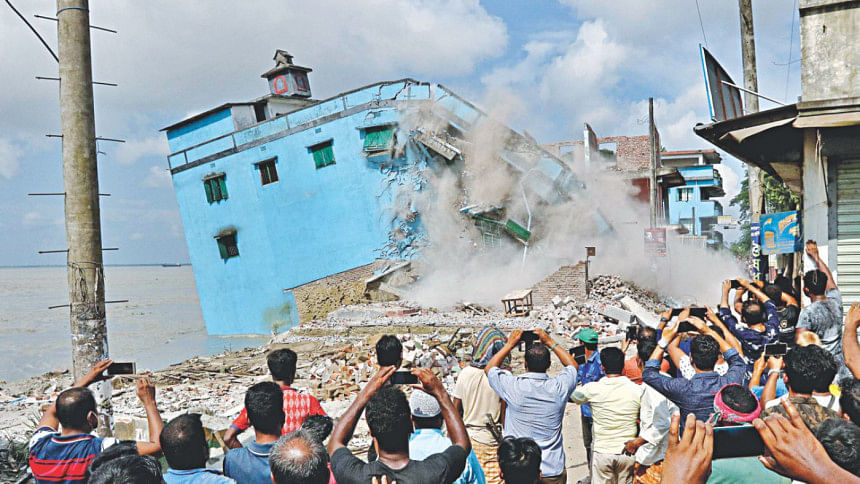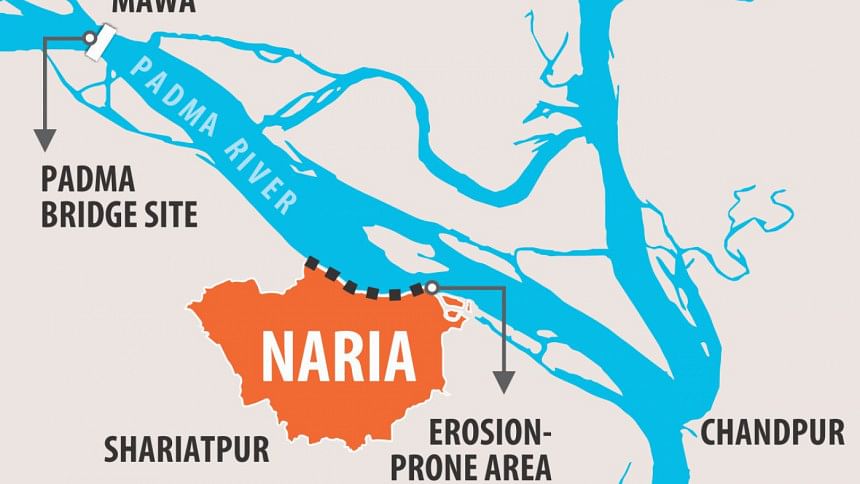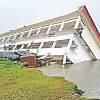Furious Padma threatens Naria

This Padma is not the river they know. At Naria of Shariatpur, 20km from the Padma Bridge construction site, it has changed abruptly for sure. Once relatively calm and quiet in the area, it turned into an all-devouring river in just a few years.
People there are on edge as the Padma changed its course and has been gobbling up village after village, making many well-off people penniless overnight.
Over the last few months alone, more than 4,000 families of five unions of Naria upazila have lost their homes, said Sanzida Yesmin, the upazila nirbahi officer.
The hungry tide now threatens to swallow the 200-year-old Mulfatganj Bazar in Naria municipality area.
“More than 10 villages of five unions, including Moktarer char, ward-2 and ward-4 of Naria municipality, Kedarpur and Gharisar, are under threat,” said Sanzida.
The river started eroding its right bank five to six years ago and people have become worried as the erosion has reached the municipality area.
“The Upazila Health Complex would be abandoned tomorrow as the river is now 10 metres from its walls,” she said on Monday.
Yesterday, locals confirmed that the government health facility was indeed abandoned with the main building only a few feet away from being devoured.
The Padma meanders its way to the Bay of Bengal from the Himalayas. It is known to be one of the few mysterious rivers in the world. The river erodes one bank and build chars on the other.
Naria had been on the good side of the Padma. “The river used to erode its left bank. But it has started eroding its right bank five to six years ago,” said Mainuddin Madbar of Mulfatganj Bazar.
On the evening of August 8, around 100 square metres of the bank near Sadhur Bazar Launch Terminal went into the river with 10 people, who were standing or working along the bank, and some shops. Only one body was recovered.
Tea stall owner Gopinath Bachhar was among the victims. A few days later the Padma took his homestead too.

Even though Parbati Bachhar, his widow, knows Gopinath is not coming back, she waits by the river, still wearing vermilion that Hindu women use on their foreheads as a sign of marriage.
“We do not know what to do now,” she said.
Everyone from her used-to-be village are on the same boat. Rich or poor, they have no home now.
Locals claimed that the river began eroding its right bank after the river training project of the Padma Bridge began at Mawa, and it has sped up this year.
“I don't know why the river is eroding the right bank. All I can tell you is that the river has changed its course,” said Swapan Kumar Das, chief scientific officer of the River Research Institute, Faridpur. He said they were conducting a survey to know why.
Safiul Islam Sheikh, executive engineer of the Bangladesh Water Development Board (BWDB), also said there was no connection between the erosion and the river training work.
In the past, the Padma current used to erode the bank on the north of Naria. “Now, the current is slamming the banks at Jajira and Naria and causing the erosion,” Safiul added.
During a visit to the area, The Daily Star correspondent found that people living near the river were spending sleepless nights. They keep an eye on the river and are ready to dismantle their homes and move.
“I was not sleeping at night. Suddenly, I heard an announcement from the mosque horn speakers. It asked those who had not yet moved to go someplace else,” said Shahid Bepari of Uttor Kedarpur in Naria.
“I went out to check and found a large chunk of our orchard near our house was gone. In the evening, I had seen the river about 50 metres away from the orchard,” said Shahid.
The launch terminal was a kilometre away from the Bepari home a month ago but now it is just 100 metres away.
Bashbari, Kedarpur and the adjacent Mulfatganj Bazar were all messy on Monday. People were busy dismantling their homes, taking window frames, doors, and roofs. Some were even pulling their homes apart brick by brick.
Traders of Mulfatganj Bazar said there were 1,500 structures of businesses in the market and all of them were under threat.
Nur Hossain Dewan, president of Mulfatganj Bazar Businessmen Association, said about 10,000 people would be affected if the bazaar was devoured entirely.
As this reporter was talking to traders there, a large three-storied building opposite the Upazila Health Complex went into the river in about 20 seconds.
Charjuria Government Primary school and Purbo Naria Primary school are also gone and 12 more schools are under threat.
“Many, who had properties worth a few hundred crores taka, became penniless,” said Ibrahim Hossain, a teacher of a local school.
UNO Sanzida said they learnt from a survey that the water was between 100 and 250 feet deep in Naria side of the Padma and was quite shallow on the other side and that a char was forming there.
When asked about the government's measures to stop the erosion, she said it had allocated Tk 5.5 crore in two phases to put sandbags in affected areas and reduce the pace of erosion. But the sandbags were no match before the current, although they weakened its force a little.
The government has now taken up a Tk 1,097 crore project to protect the right bank.
“We will start the work possibly in November,” said BWDB Executive Engineer Safiul, also the director of the bank protection project.
Mominul Haq Sarkar, deputy executive director of the Centre for Environment and Geographical Information Service (CEGIS), the agency that predicts river erosion, said they observed that the erosion had increased.
“But without conducting a study, it is not possible to say whether it is an impact of river training,” he added.

 For all latest news, follow The Daily Star's Google News channel.
For all latest news, follow The Daily Star's Google News channel. 








Comments